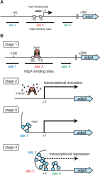Hormonal control by A-factor of morphological development and secondary metabolism in Streptomyces
- PMID: 24367152
- PMCID: PMC3859367
- DOI: 10.2183/pjab/83.277
Hormonal control by A-factor of morphological development and secondary metabolism in Streptomyces
Abstract
Streptomyces griseus, a well-known industrial producer of streptomycin, is a member of the genus Streptomyces, which shows a complex life cycle resembling that of fungi. A-factor, a C13 γ-butyrolactone compound, was discovered as a self-regulatory factor or a bacterial hormone to induce morphological differentiation and production of secondary metabolites, including streptomycin, in this organism. Accumulating evidence has revealed an A-factor-triggered signal cascade, which is composed of several key steps or components. These include: (i) AfsA catalyzing a crucial step of A-factor biosynthesis, (ii) the A-factor-specific receptor (ArpA), which acts as a transcriptional repressor for adpA, (iii) adpA, a sole target of ArpA, which encodes a global transcriptional activator AdpA, and (iv) a variety of members of the AdpA regulon, a set of the genes regulated by AdpA. A-factor is biosynthesized via five reaction steps, in which AfsA catalyzes acyl transfer between a β-ketoacyl-acyl carrier protein and the hydroxyl group of dihydroxyacetone phosphate. The receptor ArpA, belonging to the TetR family, is a homodimer, each subunit of which contains a helix-turn-helix DNA-binding motif and an A-factor-binding pocket. The three-dimensional structure and conformational change upon binding A-factor are elucidated, on the basis of X-ray crystallography of CprB, an ArpA homologue. AdpA, belonging to the AraC/XylS transcriptional activator family, binds operators upstream from the promoters of a variety of the target genes and activates their transcription, thus forming the AdpA regulon. Members of the AdpA regulon includes the pathway-specific transcriptional activator gene strR that activates the whole streptomycin biosynthesis gene cluster, in addition to a number of genes that direct the multiple cellular functions required for cellular differentiation in a concerted manner. A variety of A-factor homologues as well as homologues of afsA/arpA are distributed widely among Streptomyces, indicating the significant role of this type of molecular signaling in the ecosystem and evolutional processes.
Keywords: A-factor; A-factor receptor; Streptomyces; morphological differentiation; secondary metabolism; streptomycin biosynthesis.
Figures










Similar articles
-
The A-factor regulatory cascade leading to streptomycin biosynthesis in Streptomyces griseus : identification of a target gene of the A-factor receptor.Mol Microbiol. 1999 Oct;34(1):102-11. doi: 10.1046/j.1365-2958.1999.01579.x. Mol Microbiol. 1999. PMID: 10540289
-
AdpA, a central transcriptional regulator in the A-factor regulatory cascade that leads to morphological development and secondary metabolism in Streptomyces griseus.Biosci Biotechnol Biochem. 2005 Mar;69(3):431-9. doi: 10.1271/bbb.69.431. Biosci Biotechnol Biochem. 2005. PMID: 15784968 Review.
-
A microbial hormone, A-factor, as a master switch for morphological differentiation and secondary metabolism in Streptomyces griseus.Front Biosci. 2002 Oct 1;7:d2045-57. doi: 10.2741/A897. Front Biosci. 2002. PMID: 12165483 Review.
-
A single target is sufficient to account for the biological effects of the A-factor receptor protein of Streptomyces griseus.J Bacteriol. 2004 Apr;186(7):2206-11. doi: 10.1128/JB.186.7.2206-2211.2004. J Bacteriol. 2004. PMID: 15028707 Free PMC article.
-
Evolution of gamma-butyrolactone synthases and receptors in Streptomyces.Environ Microbiol. 2007 Aug;9(8):1986-94. doi: 10.1111/j.1462-2920.2007.01314.x. Environ Microbiol. 2007. PMID: 17635544
Cited by
-
Identification and Characterization of a Cell Wall Hydrolase for Sporangiospore Maturation in Actinoplanes missouriensis.J Bacteriol. 2019 Nov 20;201(24):e00519-19. doi: 10.1128/JB.00519-19. Print 2019 Dec 15. J Bacteriol. 2019. PMID: 31570527 Free PMC article.
-
Identification of a butenolide signaling system that regulates nikkomycin biosynthesis in Streptomyces.J Biol Chem. 2018 Dec 28;293(52):20029-20040. doi: 10.1074/jbc.RA118.005667. Epub 2018 Oct 24. J Biol Chem. 2018. PMID: 30355730 Free PMC article.
-
Rethinking Biosynthesis of Aclacinomycin A.Molecules. 2023 Mar 18;28(6):2761. doi: 10.3390/molecules28062761. Molecules. 2023. PMID: 36985733 Free PMC article. Review.
-
AvaR1, a Butenolide-Type Autoregulator Receptor in Streptomyces avermitilis, Directly Represses Avenolide and Avermectin Biosynthesis and Multiple Physiological Responses.Front Microbiol. 2017 Dec 22;8:2577. doi: 10.3389/fmicb.2017.02577. eCollection 2017. Front Microbiol. 2017. PMID: 29312254 Free PMC article.
-
Molecular characterization of a Rhodococcus jostii RHA1 γ-butyrolactone(-like) signalling molecule and its main biosynthesis gene gblA.Sci Rep. 2017 Dec 18;7(1):17743. doi: 10.1038/s41598-017-17853-6. Sci Rep. 2017. PMID: 29255143 Free PMC article.
References
-
- Hopwood, D. A. (1999) Forty years of genetics with Streptomyces: from in vivo through in vitro to in silico. Microbiology 145, 2183–2202 - PubMed
-
- Horinouchi, S. and Beppu, T. (1994) A-factor as a microbial hormone that controls cellular differentiation and secondary metabolism in Streptomyces griseus. Mol. Microbiol. 12, 859–864 - PubMed
-
- Ohnishi, Y., Yamazaki, H., Kato, J., Tomono, A. and Horinouchi, S. (2005) AdpA, a central transcriptional regulator in the A-factor regulatory cascade that leads to morphological development and secondary metabolism in Streptomyces griseus. Biosci. Biotechnol. Biochem. 69, 431–439 - PubMed
-
- Horinouchi, S. (2007) Mining and polishing of the treasure trove in the bacterial genus Streptomyces. Biosci. Biotechnol. Biochem. 71, 283–299 - PubMed
-
- Khokhlov, A. S., Tovarova, I. I., Borisova, L. N., Pliner, S. A., Schevchenko, L. A., Kornitskaya, E. Y., Ivkina, N. S. and Rapoport, I. A. (1967) A-factor responsible for the biosynthesis of streptomycin by a mutant strain of Actinomyces streptomycini. Dokl. Akad. Nauk SSSR 177, 232–235 - PubMed
Publication types
LinkOut - more resources
Full Text Sources
